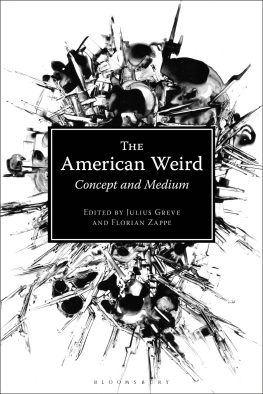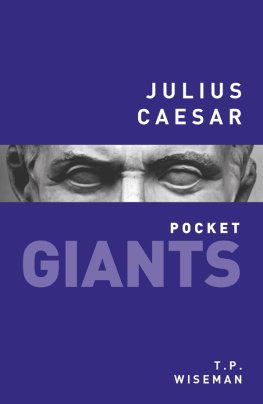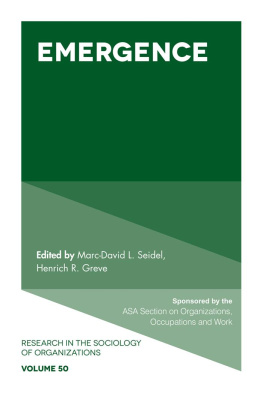Julius Greve - The American Weird
Here you can read online Julius Greve - The American Weird full text of the book (entire story) in english for free. Download pdf and epub, get meaning, cover and reviews about this ebook. publisher: Bloomsbury UK, genre: Art. Description of the work, (preface) as well as reviews are available. Best literature library LitArk.com created for fans of good reading and offers a wide selection of genres:
Romance novel
Science fiction
Adventure
Detective
Science
History
Home and family
Prose
Art
Politics
Computer
Non-fiction
Religion
Business
Children
Humor
Choose a favorite category and find really read worthwhile books. Enjoy immersion in the world of imagination, feel the emotions of the characters or learn something new for yourself, make an fascinating discovery.
- Book:The American Weird
- Author:
- Publisher:Bloomsbury UK
- Genre:
- Rating:4 / 5
- Favourites:Add to favourites
- Your mark:
- 80
- 1
- 2
- 3
- 4
- 5
The American Weird: summary, description and annotation
We offer to read an annotation, description, summary or preface (depends on what the author of the book "The American Weird" wrote himself). If you haven't found the necessary information about the book — write in the comments, we will try to find it.
The American Weird — read online for free the complete book (whole text) full work
Below is the text of the book, divided by pages. System saving the place of the last page read, allows you to conveniently read the book "The American Weird" online for free, without having to search again every time where you left off. Put a bookmark, and you can go to the page where you finished reading at any time.
Font size:
Interval:
Bookmark:

The American Weird
The American Weird
Concept and Medium
Edited by
Julius Greve and Florian Zappe

Contents
The editors would like to thank the following individuals without whom The American Weird: Concept and Medium would not have been possible: Lucy Brown, Graham Harman, Marleen Knipping, Susann Khler, James Dowthwaite, Andrew S. Gross, Anca-Raluca Radu, Caro Franke, Hanna Riggert, and Jonah H. Grevethank you for your input, inspiration, patience, and support! The text of Tanya Krzywinskas chapter, Conspiracy Hermeneutics: The Secret World as Weird Tale, has previously been published in the 2014 issue of Well Played: A Journal on Video Games, Value and Meaning , 3 (2). Thanks go to Krzywinska for kindly granting permission to reprint these pages in the present book. Finally, the editors want to wholeheartedly express their gratitude to Keith Tilford for generously providing them with three phenomenal artworks for this volumethat is, for the front cover and for the two main sections of the book, Part One: Concept and Part Two: Medium .
Based on the diagram of a double chiasmatic invagination of edges by Jacques Derrida Critical Inquiry 1980. |
Skulltopus by China Miville Collapse 2009. Reproduced with the permission of China Miville. |
Concave of the Old Weird. |
Locating the New Weird. |
The corrupted form of weird fiction. |
Julius Greve and Florian Zappe
The weird is the discovery of an unhuman limit to thought that is nevertheless foundational for thought. The life that is weird is the life according to the logic of an inaccessible real...
Eugene Thacker, After Life
KEEP Austin Weird , it says on a popular bumper sticker for the city where I spend much of my time. That old Anglo-Saxon word for fate or destiny has taken on a lot of meanings. And, should you mention a coincidence to someone, they are likely to respond Weird! That kid next door who prefers to read rather than play is weird. How weird is that?
Michael Moorcock, Foreweird
How to conceptualize what is called the weird in American culture? What are its genre conventions in literary terms, and what are the dynamics that pertain to the contemporary mediations and remediations in the contexts of its nonliterary permutations: film, television, photography, video games, music, visual and performance art, and music, among others? In the spirit of Roger Luckhursts invaluable essay The Weird: A Dis/Orientation (: 57), Ngais exposition places the supposedly minor or supposedly less powerful evaluations (53), such as being cute , and their pop culture and avant-garde manifestations center stage. Why is such an approach needed in the context of contemporary American literature and culture, including the experimental poetry of Gertrude Steins Tender Buttons , the 1996 movie The Cable Guy , or the comedy show I Love Lucy (all of which are part of the canon that establishes Ngais alternative or minor aesthetic categories)?
We agree that twentieth- and twenty-first-century American culture is, indeed, structured according to a distinct set of new aesthetic forms, functions, and categories that exceeds that of the Romanticist dichotomy of the beautiful and sublime, recapitulated via Nietzsche as Apollonian order versus Dionysian force and, and via French psychoanalytical criticism as plaisir versus jouissance (see : 57). Contemporary American culture, to be sure, rests on a plethora of affective states that go beyond indifference versus difference. And Ngais set of categories is idiosyncratic and extremely useful in the context of what she describes as late capitalisms commodity fetishism indexed by cuteness, the cultural investment in discursive production indexed by the interesting, and the becoming-labor of performance (233) that she reiterates via readings of the work of performers like Lucille Ball in I Love Lucy and Richard Pryor in The Toy (7). In the latter, for instance, zaniness evokes the performance of affective laborthe production of affects and social relationshipsas it comes to increasingly trouble the distinction between work and play... under what Luc Boltanski and Eve Chiapello call the new connexionist spirit of capitalism (7).
Thus, while Ngais efforts in redefining todays aesthetico-political paradigm are on point in the contexts she discusses in her book, we would like to return to the initial set of questions voiced at the beginning of these remarks, namely by proposing the addition of the weird as yet another foundational aesthetic category of not merely, or predominantly, twentieth-century American culture, : xi).
Given its central feature of [a] certain atmosphere of breathless and unexplainable dread of outer, unknown forces (). Nonetheless, the weird remains a comparatively understudied phenomenon. We want to single out Harmans and Fishers books for a more careful analysis, because these are consistently argued monographs that develop highly useful and impactful theorizations of weird cultureLovecraftian and otherwiseas can also be seen in the influence these studies have had on the contributions in the present volume, The American Weird: Concept and Medium .
Harmans Weird Realism (: 5). That praise is based on Harmans reading of Lovecraft as a productionist author, as a tacit philosopher (one inevitably wonders if Lovecraft would have embraced such a label) who is perplexed by the gap between objects and the power of language to describe them, or between objects and the qualities they possess (3). In doing so, he renegotiates the relationship between epistemology and ontology in a way that corresponds with Harmans own philosophical viewpoint and thus offers a notion of realism that is indeedfor lack of a better word weird .
Fishers last book The Weird and the Eerie is a similarly important landmark in theorizing the weird (and its conceptual sibling, the eerie). Building on close readings of numerous manifestations of weird artLovecraft is, of course, on top of the list, David Lynch is also a key example but there are also artists and authors, such as Rainer Werner Fassbinder or Philip K. DickFisher develops a theory of weirdness defined as the presence of the inappropriate, as that which does not belong (: 10, emphasis in the original). To him, the weird is a multifaceted mode of artistic production and aesthetic experience that transcends the idea of genre. Put differently: in the conception of weirdness, the supernatural is wedded to the subcultural.
In spite of these monographs (and other studies on the topic), and in spite of the concepts undisputed significance and unbroken popularity, the weird has nonetheless remained surprisingly undertheorized so far. This volume therefore brings together perspectives from literary, cultural, media, and film studies, as well as from philosophy to provide an interdisciplinary framework to generate new approaches to answer our initial questions: How can the weird be conceptualized as a generic category, as an aesthetic mode, or as an epistemological and ontological position? What are the transformations it has undergone aesthetically and politically since its inception in the early twentieth century? Which strands of contemporary critical theory and philosophy have engaged in a dialogue with the discourses of and on the weird? And what is specifically American about this aesthetic mode? Luckhurst reminds us that
[i]t is hard to define a national tradition (is there an American weird after all?), precisely because influences are often pulled together from multiple canons. The weird might just as well contain Thophile Gautier, Franz Kafka, Gustav Meyrink, or Bruno Schulz as Herman Melville and Edgar Allan Poe. At the same time, it seems entirely plausible to extend the American weird to run from Charles Brockden Brown to the sinister comics of Charles Burns, such as Xed Out (2009), where weird affect crawls out of the gutters of his spookily disconnected panels, or the multimedia art of David Lynch, one of the best contemporary artists to grasp weird affect in cinema, TV, music, painting, and even his strip cartoon, The Angriest Dog in the World.... As if reacting like a bewildered Lovecraft narrator, the weird seems to expand and contract strangely, leaving one unable to judge with any appropriate sense of scale. ( : 202)
Font size:
Interval:
Bookmark:
Similar books «The American Weird»
Look at similar books to The American Weird. We have selected literature similar in name and meaning in the hope of providing readers with more options to find new, interesting, not yet read works.
Discussion, reviews of the book The American Weird and just readers' own opinions. Leave your comments, write what you think about the work, its meaning or the main characters. Specify what exactly you liked and what you didn't like, and why you think so.













